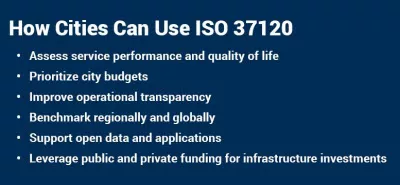
In May, the Smart Cities Council reported that a new ISO standard gives cities a common performance yardstick. Over the coming weeks we will explore this important new specification from the International Standards Organization (ISO) in depth, with a series by George Karayannis that examines each of the 17 themes and associated core and supporting indicators.
What ISO 37120:2014 provides city leaders and citizens, for the first time, is a set of clearly defined city performance indicators and a standard approach for measuring each. Though some indicators will be more helpful for cities than others, cities can now consistently apply these indicators and accurately benchmark their city services and quality of life against other cities. This is an important step forward and we believe you will find great value in this exclusive series that industry veteran George Karayannis is providing. – Jesse Berst, Smart Cities Council Chairman
By George Karayannis, LEED AP
While the formal name of the newest smart city standard (ISO 37120:2014 Sustainable development of communities – indicators for city services and quality of life) is certainly a mouthful, ISO 37120 is important in that it is the first ISO standard for smart city indicators. ISO 37120 is being developed as part of an integrated suite of standards for sustainable community development under the ISO’s Technical Committee 268.
“ISO 37120 is a milestone in the development of smart city indicators and will help city leaders guide their smart city decisions and investments,” said Michael Jansen, CEO of Cityzenith, a California-based software company working with Chicago, San Francisco, Barcelona, Amsterdam and other cities globally to deploy its standards-based 5D data integration and visualization platform
In general, ISO 37120 defines 100 city performance indicators that could or should be measured, and how. Specifically, ISO 37120 defines 46 core and 54 supporting indicators that cities either “shall” (core) or “should" (supporting) track and report. Note that ISO 37120 conformance will require third party verification of data, and the organization is in the process of defining an audit process with pilot cities. ISO 37120 also provides for a set of profile indicators, such as population and GDP, to help cities determine which cities are most relevant for comparisons.
Standard evolution
City leaders worldwide look to benchmark their service performance, learn best practices from other cities and compare their city against other cities. However, an initial effort by the Global City Indicators Facility in 2009 to compare city performance across nine pilot cities found that of 1,100 indicators, only two indicators were comparable because of differences in what cities were reporting and how. Clearly, a common approach with consistent definitions and standard methodologies was needed to help cities measure and report their service performance and quality of life. The ISO 37120 effort was launched in 2012 by city representatives from over 20 countries and evolved through five formal drafts and 300 comments. According to World Council on City Data (WCCD) President and CEO Patricia McCarney, the WCCD is now piloting ISO 37120 conformance with 17 cities globally.
Related efforts
Smart city standards and related efforts continue to proliferate globally, and ISO 37120 will need to complement these efforts or face resistance. So far, ISO 37120 appears to be establishing a solid position in the market with a unique value proposition, and the organization is actively aligning with industry organizations.
ISO 37120, unlike the STAR Community Rating System, is global in scope and is not a rating system and places no inherent value on indicator scores. Whereas C40 emphasizes city CO2 emissions measurement and reporting, ISO 37120 focuses more on factors related to energy and environmental sustainability and resiliency, including energy consumption of public buildings and average number of electrical service interruptions per year. We’ll contrast ISO 37120 with related industry initiatives, including the Council's Smart Cities Readiness Guide, after we examine each of the 17 themes in ISO 37120 in more detail in the weeks ahead.
Stay tuned
With ISO 37120, city leaders and citizens can be assured that conformity will lead to consistent tracking and accurate reporting of key performance indicators. What cities do with this information, and how they improve their indicators over time, will determine the lasting impact of this new smart city standard.
###
George Karayannis has over 25 years of emerging technology and complex solutions sales, business development and marketing experience and is currently Director Utility Sales, Trimble Energy. He has held leadership positions at Schneider Electric, Lockheed Martin Energy Solutions, AT&T and wireless sensor startups. He has also served as a city councilman and is restoring a 100-year old opera house to LEED Gold status. @gkarayannis
So far in our series:
-
- Economic indicators in the new smart city standard
- Why education may be the most important smart city indicator of all
- What the new smart city standard says about energy
- Does your city's air quality measure up to the new smart city standard?
- How debt, spending and tax collections add up in new smart city standard
- Fire and emergency response indicators -- how safe is your city?
- How voting, women and corruption figure in the smart city standard
- How healthy is your city (and what zip codes have to do with it)
- How fun is YOUR city? (And yes, it really does matter)
- How safe is your city? (Hint: run the numbers on homicides and response times)
- Gimme shelter, please! The homeless challenge cities face
- The long road to zero waste cities
- How connected (and innovative) is your city?
- The long road to zero waste cities
- How smart is your city about transportation?
- Why shady planning is good for smart cities
- How clean is your city's water?



